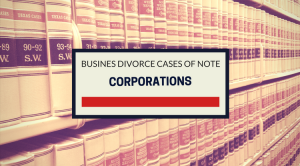-
The ‘Internal Affairs Doctrine’ requires that a court apply the law from the state in which a business was organized to disputes among the shareolders or LLC members.
-
The ‘Single Enterprise Theory’ permits a court to treat multiple entities with common ownership as though they were one.
-
In disputes involving entities from different states, when the Internal Affairs Doctrine is applied, the remedies available will vary based on the state of organization.
 In the not-so-distant past, we represented a family business organized as multiple separate entities operating in multiple states under a single administrative structure. Not surprisingly, each of the entities was organized under the law of the state in which it had its principle operations.
In the not-so-distant past, we represented a family business organized as multiple separate entities operating in multiple states under a single administrative structure. Not surprisingly, each of the entities was organized under the law of the state in which it had its principle operations.
When it all went South and a dispute over the control of the businesses divided the family members involved,we were faced with the conundrum of where to file. The remedies and the reach of the authority of the courts in the different jurisdiction created a clear conflict of laws. It’s not common to have such a complicated, but it is not a rarity either.
Closely Held Businesses: The Single Enterprise Theory
Our approach has been to argue that – at least as the claims among the principals are concerned – they are a single entity: a single organization that should be treated as such. The concept has gained some acceptance under a few different theories. If they are treated as one entity, then what law applies?
More Questions? Learn More. You can call me at 973-602-3915 or use our Contact form to reach me by email.
The choice of law issue is difficult when there is a single entity organized under foreign law that is involved in the suit. Now suppose that this organization is comprised on entities organized under New York, New Jersey and Pennsylvania law. The internal affairs doctrine holds that the law of each state applies to claims between ifs owners, officers and directors.
The First Department of the Appellate Division of New York Supreme Court recently reaffirmed the applicability of the doctrine in Ezrasons, Inc. v. Rudd, a derivative action seeking recover in a derivative action involving Barclays PLC. In dismissing the case, the First Department said that the internal affairs doctrine dictates that claims concerning the relationship between the corporation, its directors, and a shareholder are governed by the state or country of incorporation.
New York Adheres to Internal Affairs Doctrine
Barclays was an English corporation and the English Companies Act requires a derivative plaintiff to be a member of the company. Ezrasons was not a member and therefore lacked standing. New York’s Business Corporations Law (BCL) gives the court jurisdiction to hear derivative claims involving foregin companies, but the substantive law applicable to its internal affairs is always that of the state of organization.
In New Jersey, however, an unreported decision of the Appellate Division recently reversed and remanded a derivative claim involving a Delaware limited liability company, holding that a traditional choice of law analysis was applicable. The first step of that process, the Appellate Division held was to ascertain if there was an actual conflict between the state in which the action was being heard and the state where it was was organized.
New Jersey Conflict of Laws Analysis May Trump Internal Affairs Doctrine
The Appellate Division found between New York and New Jersey law and applied the law of New Jersey to the derivative claims at issue. We wrote about that decision recently. (New Jersey Court Rejects Choice of Delaware Law Under RULLCA) Even though New Jersey has adopted a statutory application of the internal affairs doctrine, the court used the traditional analysis.
Derivative claims are an example of the problems that can arise. New Jersey allows a party to plead demand futility, as does New York, but in New Jersey a trial judge has discretion to disregard the rules concerning derivative liability in some circumstances. Pennsylvania has a general hard rule prohibiting futility pleading and requires the business to have an opportunity to have the claims investigated by an independent committee.
New Jersey and Pennsylvania permit the expulsion of limited liability company members, known as involuntary dissociation, while New York does not. In Pennsylvania the claim for involuntary dissociation can be brought by a member or the company. In New Jersey, only by the company.
New Jersey has no minimum ownership requirement for oppressed shareholder actions involving corporations. In New York, the plaintiff in an oppressed shareholder action must own at least 20 percent of the shares. The New York corporation can exercise a right to purchase the shares of the plaintiff for fair value, converting the oppression claim into a claim over the value of the shares that the plaintiff must now sell.
Amalgamation Avoids Conflict of Laws Issue
That brings us to the issue of what to do with multiple business entities organized under the law of multiple states. The idea of a “single business entity” or an “amalgamation” has been explicitly addressed only by the courts of South Carolina and Texas. The underlying theory behind the South Carolina Supreme Court has been a combination of a piercing the veil theory and conflicts of law analysis.
The seminal decision, Petruis v. Front Roe Restaurants, involved a South Caroling entity at the hub of the enterprise and a South Carolina plaintiff claiming that he had been wronged. The Supreme Court was willing to look beyond the black letter rule, noting that veil piercing cases involve disputes that “reach beyond the confines of the corporation.”
[T]his threshold amalgamation issue is not as much a question of the inner-workings of foreign corporations as it is an assessment of whether these entities actually operate as a single business enterprise, and thus should be treated as a single entity. Further, one of the three corporate entities, Front Roe, is a South Carolina corporation; much of the conduct at issue occurred, at least in part, in South Carolina; and Pertuis, the minority shareholder, is a South Carolina resident. Accordingly, we conclude the application of South Carolina law is appropriate and that the internal affairs doctrine does not bar our review of this issue.
Where does that leave the parties in a multi-jurisidictional, multi- entity dispute. The amalgamation theory may be the only viable pathway to relief. New York courts, for example, will not grant relief that implicates the sovereignty of another. New Jersey seems as though it has a more liberal approach to choice of law analysis. The outcome is simply uncertain at this point.
 The Business Divorce Law Report
The Business Divorce Law Report


 Statutes: S.C. Code Ann. § 33-18-420; S.C. Code Ann. § 33-15-105; S.C. Code Ann. § 33-18-200 to -210; S.C. Code Ann. § 33-18-220; S.C. Code Ann. § 33-18-230; N.C. Gen. Stat. § 55-14-31
Statutes: S.C. Code Ann. § 33-18-420; S.C. Code Ann. § 33-15-105; S.C. Code Ann. § 33-18-200 to -210; S.C. Code Ann. § 33-18-220; S.C. Code Ann. § 33-18-230; N.C. Gen. Stat. § 55-14-31